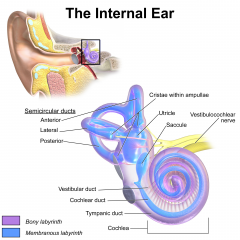Hearing in the Elderly
Original Editor - Wendy Walker
Top Contributors - Wendy Walker, Kim Jackson, Scott Buxton, Tony Lowe, WikiSysop, Lucinda hampton and Kirenga Bamurange Liliane
Introduction[edit | edit source]
The sense of hearing is of paramount importance in spoken communication, and age-related hearing loss can lead to porblems with communication, decreased awareness of environmental clues and even social isolation.
Histologic changes associated with aging occur throughout the auditory system from the hair cells of the cochlea to the auditory cortex in the temporal lobe of the brain.
The international incidence of impaired hearing in the elderly varies among societies, but most of the world's population experiences some degree of decline in hearing with advancing age.
In the USA approximately 25-30% of people aged 65-74 years are estimated to have impaired hearing. For people aged 75 years and older, this incidence is thought to rise to 40-50%.
A UK study[1] found that 80% of hearing impaired people are over the age of 60.
Relevant Anatomy[edit | edit source]
Outer Ear[edit | edit source]
The outer ear includes the portion of the ear that we see—the pinna/auricle and the ear canal.
Pinna[edit | edit source]
The pinna or auricle is a concave cartilaginous structure, which collects and directs sound waves traveling in air into the ear canal or external auditory meatus.
Ear Canal[edit | edit source]
The ear canal or external auditory meatus is approximately 1.25 inches long and .25 inch in diameter. The inner two-thirds of the ear canal is imbedded in the temporal bone. The outer one-third of the canal is cartilage. Although the shape of each ear canal varies, in general the canal forms an elongated "s" shape curve. The ear canal directs airborne sound waves towards the tympanic membrane (eardrum). The ear canal resonates sound waves and increases the loudness of the tones in the 3000-4000 Hz range.
The ear canal maintains the proper conditions of temperature and humidity necessary to preserve the elasticity of the tympanic membrane. Glands, which produce cerumen (earwax) and tiny hairs in the ear canal, provide added protection against insects and foreign particles from damaging the tympanic membrane.
Conductive Hearing Loss[edit | edit source]
Sensorineural Hearing Loss[edit | edit source]
Presbycusis[edit | edit source]
Recent Related Research (from Pubmed)[edit | edit source]
Extension:RSS -- Error: Not a valid URL: Feed goes here!!|charset=UTF-8|short|max=10
References[edit | edit source]
References will automatically be added here, see adding references tutorial.
- ↑ Epidemiological profile of hearing impairments: the scale and nature of the problem with special reference to the elderly.fckLRDavis ACfckLRActa Otolaryngol Suppl. 1990;476:23.







